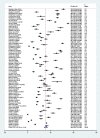A systematic review and meta-analysis of studies exploring prevalence of non-specific anxiety in undergraduate university students
- PMID: 37041470
- PMCID: PMC10088287
- DOI: 10.1186/s12888-023-04645-8
A systematic review and meta-analysis of studies exploring prevalence of non-specific anxiety in undergraduate university students
Abstract
Background: Anxiety is a common mental health problem in the general population, and is associated with functional impairment and negative impacts upon quality of life. There has been increased concern about university students' mental health in recent years, with a wide range of non-specific anxiety rates reported worldwide in undergraduate university students. We aimed to explore prevalence of non-specific anxiety in undergraduate university student populations.
Methods: Four databases were searched to identify studies published between 1980 and 2020 which investigated prevalence of non-specific anxiety in undergraduate university students. Each study's quality was appraised using a checklist. Sub-analyses were undertaken reflecting outcome measure utilized, course of study, location of study, and whether study was before or during the COVID-19 pandemic.
Results: A total of 89 studies - representing approx. 130,090 students-met inclusion criteria. Eighty-three were included in meta-analysis, calculating a weighted mean prevalence of 39.65% (95% CI: 35.72%-43.58%) for non-specific anxiety. Prevalence from diagnostic interview studies ranged from 0.3%-20.8% 12-month prevalence. Prevalence varied by outcome measure used to assess non-specific anxiety, the type of course studied by sample, and by study location. In half the studies, being female was associated with being more likely to have higher non-specific anxiety scores and/or screening above thresholds. Few of the included studies met all quality appraisal criteria.
Conclusion: The results suggest that approximately a third of undergraduate students are experiencing elevated levels of non-specific anxiety. Results from sub-analyses have identified some methodological issues that need consideration in appraising prevalence in this population.
Keywords: Anxiety; Meta-analysis; Prevalence; Students; Systematic review.
© 2023. The Author(s).
Conflict of interest statement
The authors declare that they have no competing interests.
Figures
References
-
- National Institute for Health and Care Excellence . Quality Standard [QS53]: Anxiety Disorders. 2014.
-
- Olatunji BO, Cisler JM, Tolin DF. Quality of life in the anxiety disorders: A meta-analytic review. Clin Psychol Rev. 2007;27(5):572–581. - PubMed
-
- World Health Organization. International statistical classification of diseases and related health problems, 10th revision, Fifth edition, 2016. World Health Organization; 2015. https://apps.who.int/iris/handle/10665/246208.
-
- World Health Organisation . Depression and Other Common Mental Disorders: Global Health Estimates. Geneva: World Health Organisation; 2017.
Publication types
MeSH terms
Grants and funding
LinkOut - more resources
Full Text Sources
Medical
Miscellaneous



